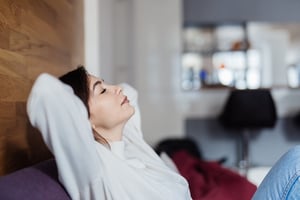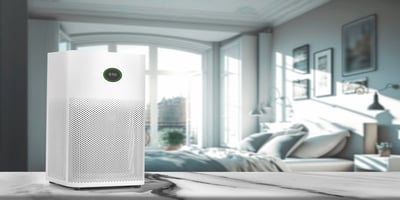Clearing the Air: Do Air Purifiers Remove CO2?
Key Takeaways
- Air purifiers do not remove CO2 from indoor spaces. Standard air purification technologies—HEPA filters, activated carbon, UV-C—are designed for particulate matter, allergens, and gases like VOCs, not carbon dioxide molecules.
- CO2 is too small and abundant for filtration. Unlike dust or allergens, CO2 molecules are tiny and present in concentrations (300-1,000 ppm) that air purifiers aren't built to address.
- Elevated CO2 causes real health effects. High indoor CO2 levels impair cognitive function, cause headaches and fatigue, reduce productivity, and disrupt sleep quality—symptoms often mistakenly attributed to other causes.
- Ventilation is the only effective CO2 solution. Fresh outdoor air exchange—through open windows, mechanical ventilation systems, or exhaust fans—remains the primary method for reducing indoor CO2 concentrations.
Air purifiers help indirectly. While they can't filter CO2, they improve overall air quality by removing pollutants from combustion sources and enhancing air circulation, creating a healthier environment that may reduce CO2 accumulation factors.
We spend roughly 90% of our lives indoors. That makes indoor air quality more than a comfort issue—it's a health priority. While most people focus on dust, allergens, and VOCs, there's a growing concern that often gets overlooked: carbon dioxide levels.
Unlike other pollutants, CO2 is unavoidable. Every breath we take in enclosed spaces adds to the concentration. Crowded offices, poorly ventilated classrooms, and sealed-up homes can accumulate CO2 faster than fresh air replaces it. The result? Headaches, fatigue, impaired concentration—symptoms many people dismiss as normal workday tiredness.
This raises a practical question: can air purifiers remove CO2 from indoor spaces? The answer isn't straightforward. In this article, we'll examine how CO2 behaves differently from other pollutants, what air purifiers actually filter, and whether they're the right solution for your indoor air concerns.
-
What is CO2 and Where Does it Come From?
-
Introducing Air Purifiers and Their Primary Function
-
Addressing Common Misconceptions about Air Purifiers and CO2 Removal
-
Can Air Purifiers Remove CO2?
-
Practical Tips for CO2 Reduction
-
FAQ
What is CO2 and Where Does it Come From?
Carbon dioxide, denoted as CO2, is a colorless, odorless gas that is naturally present in the Earth's atmosphere. It is a vital component of the carbon cycle and plays a pivotal role in maintaining the planet's temperature. In the context of indoor environments, CO2 takes on particular significance due to its influence on air quality, breathing and the health and comfort of occupants.
Indoor air quality (IAQ) is a critical aspect of our overall well-being, as we spend a substantial portion of our lives inside buildings. CO2 is one of the key indicators used to assess IAQ. Elevated CO2 levels can indicate poor ventilation and a buildup of other indoor air pollutants and pollutants, which can have adverse effects on health and comfort.
Common Sources of CO2 Indoors:
- Human Respiration: One of the most significant sources of indoor CO2 is the exhalation of breath by occupants. With every breath, humans release carbon dioxide into the air, and in enclosed spaces with limited ventilation, this can lead to a gradual increase in CO2 levels.
- Combustion Appliances: Various appliances, such as stoves, furnaces, water heaters, and gas-powered vehicles parked in garages, produce carbon dioxide as a byproduct of combustion. Poorly ventilated spaces can trap CO2 emissions, leading to higher concentrations.
- Occupancy and Activities: The number of people in a room and their level of physical activity contribute to CO2 production. Crowded gatherings or strenuous activities can lead to faster CO2 accumulation.
- Building Materials and Furnishings: Some building materials and furnishings, particularly those containing adhesives and foams, can release volatile organic compounds (VOCs). VOC emissions can react with indoor air, indirectly contributing to elevated CO2 levels.
Health and Comfort Implications of High CO2 Levels
Maintaining appropriate CO2 levels is not just a matter of comfort; it's also essential for health. High concentrations or elevated levels of CO2 can lead to several adverse effects:
- Reduced Cognitive Function: Elevated CO2 levels have been linked to impaired cognitive function, making it more challenging to concentrate and make decisions.
- Discomfort and Fatigue: Occupants in spaces with high CO2 may experience symptoms like drowsiness, headaches, and a general feeling of discomfort.
- Increased Respiratory Issues: Prolonged exposure to elevated CO2 levels can exacerbate respiratory conditions and allergies.
- Decreased Productivity: In workplaces, high CO2 levels can result in decreased productivity and overall well-being of employees.
- Poor Sleep Quality: Bedrooms with inadequate ventilation can accumulate CO2 during the night, potentially leading to restless sleep.
Introducing Air Purifiers and Their Primary Function
Air purifiers, also known as air cleaners or air filtration systems, have emerged as essential tools in the pursuit of healthier indoor environments. These devices are specifically designed to improve indoor air quality (IAQ) by removing or reducing various airborne pollutants, allergens, and contaminants. The primary function of air purifiers is to cleanse the air we breathe within enclosed spaces, creating a fresher and safer environment.
Addressing Common Misconceptions about Air Purifiers and CO2 Removal
While air purifiers are effective at removing many pollutants from indoor air, there are common misconceptions regarding their ability to remove carbon dioxide (CO2). It's important to clarify these points:
- Air purifiers are not specifically designed to remove CO2: The primary function of most air purifiers is to target particulate matter, allergens, and gases, rather than CO2. They are not typically equipped with mechanisms to directly reduce CO2 levels.
- CO2 is not a common pollutant removed by air purifiers: CO2 molecules are relatively small and abundant in indoor spaces, making them challenging to capture with standard air purification technologies.
- Improving ventilation is the key: To effectively reduce CO2 levels, enhancing ventilation by introducing fresh outdoor air is a more practical approach. Mechanical ventilation systems and opening windows can help dilute indoor CO2 concentrations.
In the following section, we will delve deeper into the question of whether air purifiers can play a role in indirectly influencing CO2 levels by addressing other pollutants that contribute to indoor CO2 accumulation.
 Can Air Purifiers Remove CO2?
Can Air Purifiers Remove CO2?
While air purifiers excel at removing a wide range of airborne pollutants, their ability to directly remove carbon dioxide (CO2) from indoor environments is limited. CO2 molecules are relatively small and not easily trapped by standard air purification technologies such as HEPA filters or other activated carbon filters.
Scientific studies of air filter used have generally focused on the removal of particulate matter, allergens, and gases like volatile organic compounds (VOCs) rather than CO2. Consequently, there is limited empirical evidence to support the idea that air purifiers can significantly reduce indoor CO2 levels through direct filtration.
Discussing Limitations and Challenges
Several factors contribute to the limitations and challenges of air purifiers in the context of CO2 removal by air purifier:
- CO2 Molecule Size: CO2 molecules are small (with a molecular weight of 44 grams per mole), making them challenging to capture effectively with the mechanisms commonly found in air purifiers designed for larger particles.
- Concentration Levels: CO2 is a natural component of indoor air, and its concentrations are typically in the range of 300 to 1,000 parts per million (ppm). Air purifiers are not designed to address such low concentrations, as their primary focus is on pollutants that are more significant health concerns.
- Limited Mechanisms: Air purifiers primarily use filtration, adsorption, or UV-C technologies, which are not optimized for CO2 removal. These mechanisms are better suited for capturing particulate matter, gases, and odors.
Exploring Indirect Impacts on CO2 Levels
Although air purifiers may not directly remove CO2, they can have indirect effects on CO2 levels by less dust and improving indoor air quality in other ways:
- Improved Ventilation: Some air purifiers are equipped with fans that can enhance air circulation within a room. This improved air movement can help distribute fresh outdoor air and, to some extent, dilute indoor CO2 concentrations.
- Removal of CO2 Sources: Air purifiers can remove pollutants and odors generated by combustion processes or other indoor sources. By reducing these emissions, they indirectly mitigate the factors contributing to elevated CO2 levels.
- Enhanced Comfort: Air purifiers can help create a more comfortable indoor environment, making occupants less likely to open windows or doors for ventilation, especially in areas with outdoor air pollution or allergen concerns.
 Practical Tips for CO2 Reduction
Practical Tips for CO2 Reduction
Maintaining healthy indoor air quality with a focus on reducing carbon dioxide (CO2) levels involves a combination of strategies that encompass ventilation, lifestyle changes, and other practical measures to clean air further. Here are some tips to help you achieve better indoor air quality and manage CO2 effectively:
- Increase Ventilation: Adequate ventilation is essential for reducing CO2 levels. Open windows and doors to allow fresh outdoor air to flow into your living spaces regularly, especially in areas where CO2 emissions are high (e.g., kitchens, crowded rooms). Consider using exhaust fans in bathrooms and kitchens to enhance airflow.
- Use Mechanical Ventilation: In addition to natural ventilation, mechanical ventilation systems with heat recovery can help maintain consistent air exchange rates without compromising energy efficiency. These systems can be especially beneficial in tightly sealed homes.
- Monitor CO2 Levels: Invest in a CO2 monitor to keep track of indoor concentrations. This device can provide real-time feedback and help you identify when additional ventilation or other measures are necessary.
- Limit Indoor Activities: Reduce activities that generate excess CO2 indoors, such as burning candles or using gas stoves without proper ventilation. Minimize the use of space heaters and other combustion appliances.
- Utilize Houseplants: Certain houseplants, such as snake plants, peace lilies, and spider plants, can help improve indoor air quality by absorbing CO2 during photosynthesis. While they may not eliminate high CO2 levels on their own, they can complement other strategies.
- Choose Low-Emission Materials: When renovating or furnishing your home, opt for low-VOC (volatile organic compound) paints, adhesives, and building materials. Reducing indoor pollutants can indirectly mitigate CO2 buildup.
- Lifestyle Changes: Encourage lifestyle changes that can reduce CO2 emissions indoors. For example, limit smoking indoors, encourage energy-efficient cooking practices, and use exhaust fans when using gas-powered appliances.
- Adjust Occupancy Patterns: Be mindful of the number of people in a room and their activity levels. High occupancy and physical activity can lead to faster CO2 accumulation. Ensure adequate ventilation during gatherings or events.
- Consider Air Purifiers: While air purifiers may not directly remove CO2, they can help improve indoor air quality by reducing other pollutants, making the indoor environment more comfortable and less susceptible to CO2 accumulation.
- Seek Professional Guidance: If you are concerned about CO2 levels and indoor air quality in your home or workplace, consult with HVAC professionals, indoor air quality experts, or building engineers. They can provide recommendations tailored to your specific situation.
- Practice Good Maintenance: Regularly maintain your HVAC system, air purifiers, air filters, and exhaust fans to ensure they operate efficiently. Clean or replace filters as needed to prevent airflow restrictions.
Remember that maintaining healthy indoor air quality is a multifaceted endeavor. While these tips can help reduce CO2 levels, it's important to strike a balance between energy efficiency and ventilation to create a comfortable and healthy indoor environment.
FAQ
Can HEPA filters remove CO2?
No. HEPA filters capture particles (dust, pollen, dander) down to 0.3 microns. CO2 is a gas molecule—far smaller—and passes straight through these filters.
Do activated carbon filters remove CO2?
Not effectively. Activated carbon absorbs certain gases and odors (like VOCs), but CO2 molecules don't bind well to standard carbon filters. Specialized CO2 scrubbers exist for submarines and spacecraft, but they're not found in household air purifiers.
What is a safe indoor CO2 level?
Outdoor air contains roughly 400 ppm. Indoor levels under 800 ppm are ideal. Above 1,000 ppm, cognitive performance declines. Levels exceeding 1,500 ppm cause noticeable discomfort—headaches, fatigue, poor concentration. Bedrooms often reach 1,500-2,500 ppm overnight with closed windows.
How do I reduce CO2 in my bedroom at night?
Open a window slightly, even just a crack. Leave the bedroom door open to allow air circulation through the house. Run your HVAC fan to mix air across rooms. If outdoor air quality is poor, ventilate fully for 15-20 minutes before sleep, then close windows.
Can houseplants lower indoor CO2?
Marginally. Plants absorb CO2 during photosynthesis, but you'd need dozens of large plants to meaningfully impact a room's CO2 levels. They're a nice supplement, not a solution. Snake plants, peace lilies, and spider plants are among the more effective options.
Why does my office make me feel tired and unfocused?
Likely elevated CO2 from multiple people in poorly ventilated space. Conference rooms and crowded offices commonly exceed 1,500 ppm. Request that doors stay open between meetings, or suggest periodic window ventilation. CO2 monitors can confirm if this is your issue.
Does running an air purifier improve ventilation?
No. Air purifiers recirculate and filter existing room air—they don't introduce fresh outdoor air. Only ventilation (open windows, mechanical systems, exhaust fans) actually exchanges indoor air with outdoor air and reduces CO2.
Is high CO2 dangerous or just uncomfortable?
Both. Short-term exposure to 1,000-2,500 ppm impairs decision-making and causes discomfort. Prolonged exposure worsens symptoms. Extremely high levels (5,000+ ppm) pose serious health risks. More critically, high CO2 often indicates poor ventilation—meaning other pollutants and pathogens may also be accumulating.


































.jpg)



.jpg?height=200&name=strategic-meeting-room-setting-staged-for-crucial-business-decisions%20(1).jpg)